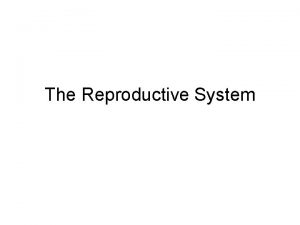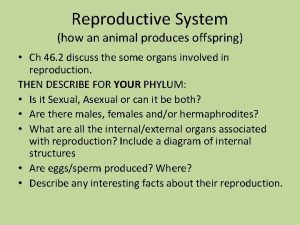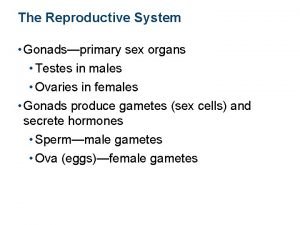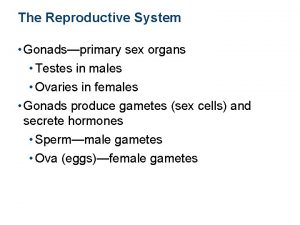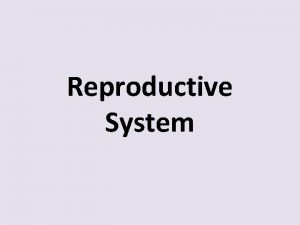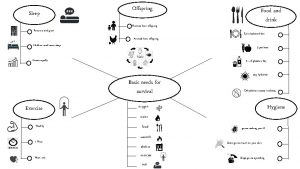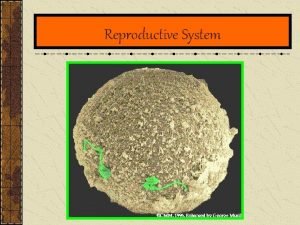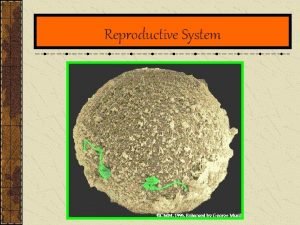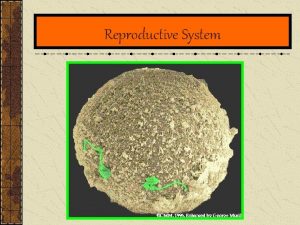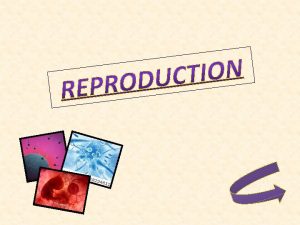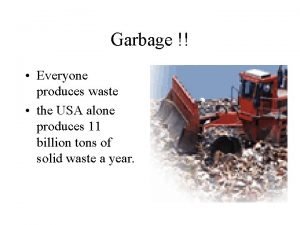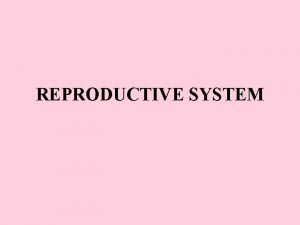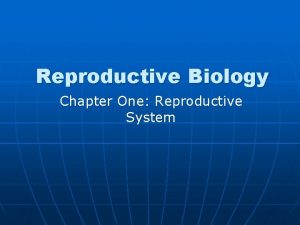Reproductive system Produces offspring The Reproductive System Gonadsprimary






























- Slides: 30

Reproductive system – Produces offspring

The Reproductive System • Gonads—primary sex organs – Testes in males – Ovaries in females • Gonads produce gametes (sex cells) and secrete hormones – Sperm—male gametes – Ova (eggs)—female gametes

• Meiosis – Males—produces four functional sperm – Females—produces one functional ovum and three polar bodies • Sex cell size and structure – Sperm are tiny and equipped with nutrients in seminal fluid – Egg is large and has nutrient reserves to nourish the embryo until implantation

Male Reproductive System Overview • Testes • Duct system – Epididymis – Vas deferens – Urethra

What is the difference between the urethra and a garden hose? There is a vas deferens. . Testes – • make sperm via meiosis. • 2 -4 million every day • The testes also produce testosterone, the male hormone.

Testosterone Production • Functions of testosterone – Stimulates reproductive organ development – Underlies sex drive (desire to mate/breed/procreate) – Causes secondary sex characteristics • • Deepening of voice Increased hair growth Enlargement of skeletal muscles Thickening of bones

Epididymus - collects mature sperm which eventually exits through the vas deferens Vas deferens - tube where sperm travel to the outside of the body. Urethra - extends from bladder to tip on penis. Carries both urine & sperm Sterilization: Vasectomy - the vas deferens is cut to prevent sperm leaving. Testosterone is still produced. Sperm can’t leave body Castration – removal of testes. No sperm. No testosterone

External genitalia • Scrotum –Divided sac of skin outside the abdomen –Holds & protects testes –Maintains tests at a slightly lower body temperature to protect sperm

Penis • Covered by sheath. • organ of copulation. • Deposits sperm into female at breeding. Long rod-like tissue.

• Sheath – protects the penis from injury

WORD BANK Vas deferens Bladder Vas deferens Urethra Seminal Vesicle Prostate Scrotum Urethra Prostate Epididymus Bladder Teste Scrotum Teste Seminal Vesicle


Structure of a Sperm Figure 16. 5 b

FEMALE REPRODUCTION Main Structures • • • Ovary Uterus Fallopian Tubes Vagina Cervix

OVARY - this is where the eggs are produced through cell division (MEIOSIS) -each ovary takes turns releasing eggs every month, twins occur if two eggs are released -Females are born with all their eggs (~400, 000) Ovaries secrete estrogen Estrogen is responsible for the appearance of secondary sex characteristics of females


Follicles • "blister like" structures that form on ovaries • A maturing ovum is held within each follicle • Release of the ova (egg) = Ovulation

• Fallopian tubes – Attached to ovaries & uterus – Receives egg from ovary – Where fertilization occurs

The uterus • where the fetus (baby) develops Regions • Body – main portion • Cervix – separates the uterus & vagina –Closes during pregnancy

Cervix • a thick-walled structure made up of several folds and rings of muscle tissue

• Vagina – Extends from cervix to exterior of body (vulva) – Birth canal – Receives male penis during intercourse

Fallopian Tubes Ovary WORD BANK Cervix Fallopian Tubes Vagina Uterus Ovary Uterus Cervix Vagina

FERTILIZATION normally occurs in the Fallopian Tubes The fertilized egg (zygote) implants in the uterus

FERTILIZATION & PREGNANCY Sperm must travel to the egg and penetrate to combine the DNA from both parents -- this creates the first cell after fertilization: the ZYGOTE 23 chromosomes from each parent; zygote has a total of 46 chromosomes


Functions of the Placenta • Forms a barrier between mother and embryo (blood is not exchanged) • Delivers nutrients and oxygen • Removes waste from embryonic blood • Becomes an endocrine organ (produces hormones) and takes over for the corpus luteum (by end of second month) by producing – Estrogen – Progesterone – Other hormones that maintain pregnancy

Identical twins One zygote Splits in 2 No one knows why! Completely random = does NOT run in families • Same exact DNA • Nature’s clones • •

Fraternal Twins • 2 separate eggs get fertilized with 2 different sperm cells • More than one egg got released during ovulation • Siblings – Can be sisters – Brother and sister • Tends to run in families

Conjoined Twins • Used to be called “Siamese” twins • First well known case was in Siam • Identical twins that never completely separated during development • Sometimes can be separated, depending on what is shared.

Virtual Pig • http: //www. whitman. edu/content/virtualpig
 This ameba would most likely be classified as a
This ameba would most likely be classified as a Where semen stored
Where semen stored Which human organ system produces sperm or egg cells? *
Which human organ system produces sperm or egg cells? * Ducts in female reproductive system
Ducts in female reproductive system Endocrine system and reproductive system
Endocrine system and reproductive system Hát kết hợp bộ gõ cơ thể
Hát kết hợp bộ gõ cơ thể Lp html
Lp html Bổ thể
Bổ thể Tỉ lệ cơ thể trẻ em
Tỉ lệ cơ thể trẻ em Voi kéo gỗ như thế nào
Voi kéo gỗ như thế nào Thang điểm glasgow
Thang điểm glasgow Chúa yêu trần thế
Chúa yêu trần thế Môn thể thao bắt đầu bằng chữ đua
Môn thể thao bắt đầu bằng chữ đua Thế nào là hệ số cao nhất
Thế nào là hệ số cao nhất Các châu lục và đại dương trên thế giới
Các châu lục và đại dương trên thế giới Cong thức tính động năng
Cong thức tính động năng Trời xanh đây là của chúng ta thể thơ
Trời xanh đây là của chúng ta thể thơ Cách giải mật thư tọa độ
Cách giải mật thư tọa độ Phép trừ bù
Phép trừ bù Phản ứng thế ankan
Phản ứng thế ankan Các châu lục và đại dương trên thế giới
Các châu lục và đại dương trên thế giới Thể thơ truyền thống
Thể thơ truyền thống Quá trình desamine hóa có thể tạo ra
Quá trình desamine hóa có thể tạo ra Một số thể thơ truyền thống
Một số thể thơ truyền thống Cái miệng nó xinh thế chỉ nói điều hay thôi
Cái miệng nó xinh thế chỉ nói điều hay thôi Vẽ hình chiếu vuông góc của vật thể sau
Vẽ hình chiếu vuông góc của vật thể sau Nguyên nhân của sự mỏi cơ sinh 8
Nguyên nhân của sự mỏi cơ sinh 8 đặc điểm cơ thể của người tối cổ
đặc điểm cơ thể của người tối cổ Ví dụ về giọng cùng tên
Ví dụ về giọng cùng tên Vẽ hình chiếu đứng bằng cạnh của vật thể
Vẽ hình chiếu đứng bằng cạnh của vật thể Fecboak
Fecboak































